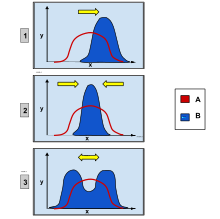
In population genetics, directional selection is a type of natural selection in which one extreme phenotype is favored over both the other extreme and moderate phenotypes. This genetic selection causes the allele frequency to shift toward the chosen extreme over time as allele ratios change from generation to generation. The advantageous extreme allele will increase as a consequence of survival and reproduction differences among the different present phenotypes in the population. The allele fluctuations as a result of directional selection can be independent of the dominance of the allele, and in some cases if the allele is recessive, it can eventually become fixed in the population.[1][2]
Directional selection was first identified and described by naturalist Charles Darwin in his book On the Origin of Species published in 1859.[3] He identified it as a type of natural selection along with stabilizing selection and disruptive selection.[4] These types of selection also operate by favoring a specific allele and influencing the population's future phenotypic ratio. Disruptive selection favors both extreme phenotypes while the moderate trait will be selected against. The frequency of both extreme alleles will increase while the frequency of the moderate allele will decrease, differing from the trend in directional selection when only one extreme allele is favored. Stabilizing selection favors the moderate phenotype and will select against both extreme phenotypes.[5] Directional selection can be observed in finch beak size, peppered moth color, African cichlid mouth types, and sockeye salmon migration periods.
If there is continuous allele frequencies changes as a result of directional selection generation to generation, there will be observable changes in the phenotypes of the entire population over time. Directional selection can change the genotypic and phenotypic variation of a population and cause a trend toward one specific phenotype.[6] This selection is an important mechanism in the selection of complex and diversifying traits, and is also a primary force of speciation.[7] Changes in a genotype and consequently a phenotype can either be advantageous, harmful, or neutral and depend on the environment in which the phenotypic shift is happening.[8]
- ^ Molles, MC (2010). Ecology Concepts and Applications. McGraw-Hill Higher Learning.
- ^ Teshima, Kosuke M.; Przeworski, Molly (January 2006). "Directional Positive Selection on an Allele of Arbitrary Dominance". Genetics. 172 (1): 713–718. doi:10.1534/genetics.105.044065. PMC 1456198. PMID 16219788.
- ^ Kaiser, Margaret (November 2014). "First editions of Darwin's 'Origin of Species'". National Library of Medicine.
- ^ Darwin, C (1859). On the origin of species by means of natural selection, or the preservation of favoured races in the struggle for life. London: John Murray.
- ^ Mitchell-Olds, Thomas; Willis, John H.; Goldstein, David B. (2007). "Which evolutionary processes influence natural genetic variation for phenotypic traits?". Nature Reviews Genetics. 8 (11). Springer Nature: 845–856. doi:10.1038/nrg2207. ISSN 1471-0056. PMID 17943192. S2CID 14914998.
- ^ Melo, Diogo; Marroig, Gabriel (January 2015). "Directional selection can drive the evolution of modularity in complex traits". Proceedings of the National Academy of Sciences of the United States of America. 112 (2): 470–475. Bibcode:2015PNAS..112..470M. doi:10.1073/pnas.1322632112. PMC 4299217. PMID 25548154.
- ^ Rieseberg, Loren H.; Widmer, Alex; Arntz, A. Michele; Burke, John M. (September 2002). "Directional selection is the primary cause of phenotypic diversification". Proceedings of the National Academy of Sciences. 99 (19): 12242–12245. Bibcode:2002PNAS...9912242R. doi:10.1073/pnas.192360899. PMC 129429. PMID 12221290.
- ^ Thiltgen, Grant; dos Reis, Mario; Goldstein, Richard A. (December 2016). "Finding Direction in the Search for Selection". Journal of Molecular Evolution. 84 (1): 39–50. doi:10.1007/s00239-016-9765-5. PMC 5253163. PMID 27913840.